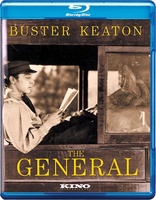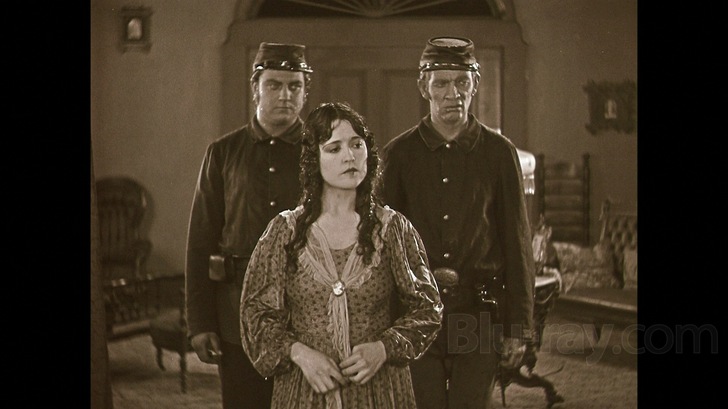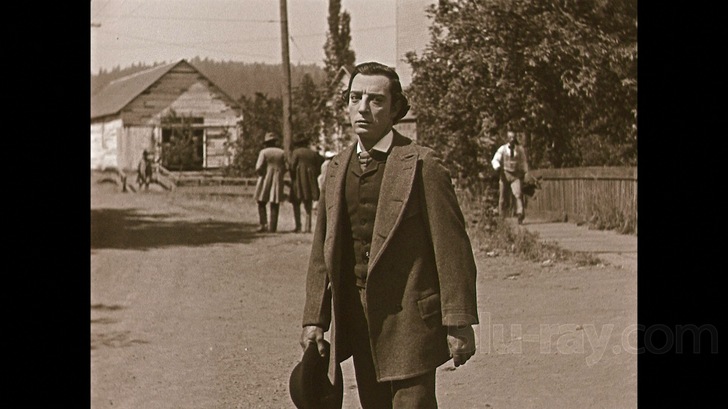The General Blu-ray Movie
HomeThe General Blu-ray Movie 
Kino Lorber | 1926 | 78 min | Not rated | Nov 10, 2009
Movie rating
8.5 | / 10 |
Blu-ray rating
| Users | 4.8 | |
| Reviewer | 4.5 | |
| Overall | 4.5 |
Overview
The General (1926)
Johnnie loves two things: his train and the lovely Annabelle Lee. When the Civil War breaks out he enlists as a soldier, but it is decided that he is too valuable as an engineer. Annabelle thinks it is because he is a coward. When Union spies capture Johnnie with Annabelle on board, Johnnie "The General" must recue both his loves.
Starring: Buster Keaton, Marion Mack, Glen Cavender, Jim Farley (I), Frederick VroomDirector: Buster Keaton, Clyde Bruckman
| Drama | Uncertain |
| Romance | Uncertain |
| Western | Uncertain |
| War | Uncertain |
| Comedy | Uncertain |
| Adventure | Uncertain |
| Action | Uncertain |
Specifications
Video
Video codec: MPEG-4 AVC
Video resolution: 1080p
Aspect ratio: 1.34:1
Original aspect ratio: 1.33:1
Audio
Music: DTS-HD Master Audio 5.1
Music: LPCM 2.0 (48kHz, 16-bit)
Music: Dolby Digital 2.0
Music: Dolby Digital 2.0
Subtitles
None
Discs
50GB Blu-ray Disc
Single disc (1 BD)
Playback
Region free
Review
Rating summary
| Movie | 5.0 | |
| Video | 4.5 | |
| Audio | 4.0 | |
| Extras | 2.5 | |
| Overall | 4.5 |
The General Blu-ray Movie Review
A silent classic makes a bang on Blu-ray.
Reviewed by Casey Broadwater November 10, 2009He’s called The Great Stone Face, because his is worthy of a seaward-gazing spot on Easter Island— stoic, deadpan, a blank onto which we can project our own emotions. He played it straight, never hamming for the camera, never breaking character to sell a gag, always moving deliberately, with a knowing clumsiness that can only be described as graceful. And yet, in his own time, Buster Keaton pratfell into the shadow of Charlie Chaplin, that other silent comic mastermind. It’s arguable who was the greatest—I’d hate to choose between Steamboat Bill Jr. and The Kid—but recent critical revision has seemingly sided with Keaton. No mere slapstick artist, Buster Keaton was a comedic genius with the agility of a ballerina and the timing of a metronome. As a director of his own films, he crafted sequences of kinetic insanity—performing his own frequently dangerous stunts—and ultimately influencing the physical comedy of everything from Looney Toons to Jackie Chan. Perhaps his greatest film—and the one that temporarily ended his career—is The General, a madcap train-bound chase that was a box-office bust upon it’s 1927 release, but has since gone on to be recognized as one of the greatest comedies of the silent era. Or any era, for that matter.

Johnnie Gray, Engineer.
In 1862, a small group of Union soldiers snuck behind enemy lines and commandeered a locomotive, driving it northbound and tearing up track, throwing switches, and severing telegraph wires along the way. They were caught—and most of them hanged—but William Pittenger survived to write a memoir, The Great Locomotive Chase. Some 64 years after the incident, the book landed in the hands of Buster Keaton, who saw it as prime material for comedy. Only, there’s really nothing funny about a group of soldiers getting caught and killed. So, Keaton flipped allegiances and decided to tell the story from the perspective of the southern engineer whose train was stolen. The actual train—which was called The General—was decommissioned but still in existence somewhere in Georgia, and Keaton initially secured it for use in the film. However, when the Confederate Veterans of the South caught wind that the film was going to be a comedy—gasp—their gad-dum consternations and complaints were enough to send Keaton packing to the Pacific Northwest, where he found a few nearly identical trains to use. Shooting then commenced on one of the most expensive films of the silent era.
Keaton himself plays Johnnie Gray, an engineer with two loves: his engine and the willowy Annabelle Lee (Marion Mack). When the war breaks out, Johnnie tries to enlist, but he’s turned down because he’s more valuable to the South as an engine driver. Of course, no one bothers to tell him this, and his dejection is comically painful when he starts comparing himself to the tall, fit, newly enlisted soldiers leaving the recruiting office. This gives way to true sadness when Annabelle calls him a coward and refuses to speak with him until he’s dressed in uniform. A year later, Johnnie is piloting The General when it gets hijacked by Union soldiers disguised as civilians. Annabelle happens to be on the train and gets kidnapped. Johnnie gives chase—on foot, with a handcar, on a wooden penny-farthing bicycle, and finally in another steam locomotive, The Texas. Alone behind enemy lines, Johnnie abandons the train and accidentally infiltrates the Union headquarters, where he rescues Annabelle. The next morning, they retake The General, the northern soldiers pursue in The Texas, and the whole chase happens again in reverse. For the film’s climax, Keaton sends The Texas across a burning bridge, which collapses into the river below right as the train is mid-way across. This was the single most expensive scene in silent movie history—reputedly costing $42,000, an astronomical sum at the time. The locamotive remained lodged in the river until it was dismantled for scrap during WWII.
There’s a scene in The Darjeeling Limited, Wes Anderson’s latter-day train classic, where the passenger train gets lost in the desert. “How can a train be lost?” says Jack. “It’s on rails.” While no locomotives get lost in The General—at least, not in that way—Buster Keaton deals in the same kind of absurdities. Great comedians of the day were known for their “gags,” and Keaton seemingly dreamed them up and executed them effortlessly. You would think two trains chasing one another couldn’t possibly be exciting or funny—they’re both stuck on tracks— but Keaton finds a comedic beat for every situation, from a mishap with an enormous cannon to repeated dousings from the track-side water tank. One thing that’s clear when watching the film is that there’s no way it could be created today; the stunts are genuinely dangerous and I have trouble believing any insurer would carry the risk. Watch as Keaton darts in front of a moving train to remove a plank of wood from the tracks; the train catches up with him and he falls back onto the cowcatcher, where he tosses the piece of wood into another track-lodged log, sending both pieces catapulting out of the way. Any misstep would find Keaton being pulverized into ground comedian beneath the train.
For all the danger and excitement, it’s Keaton’s droll and weary humanity that elevates The General from a zany silent comedy to a truly timeless classic. My favorite scene is when Johnnie and Annabelle have re-stolen The General and are trying to escape their Northern pursuers. Annabelle wants to make herself useful, so she starts loading wood into the engine’s stove. One large chunk of wood has a hole in it, so Annabelle promptly throws it out of the cabin, picking up a small sliver to toss into the fire instead. Seeing this, Johnnie hands her an even smaller piece. When she throws that piece into the fire, he mock strangles her in exasperation before planting a tiny kiss on her cheek. It’s a moment that exemplifies both Keaton’s comic timing and the brilliantly understated tenderness that underscores the entire film.
The General Blu-ray Movie, Video Quality 

Let me preface this section by just saying that watching The General on Blu-ray is an absolute pleasure. As the first silent film to make the jump to high definition in the United States, I'm sure a lot of people are looking toward The General as a litmus test for how well films from the '20s will perform on Blu-ray. Of course, quality will inevitably vary due to print damage, etc., but I can say that I was consistently impressed by the 1080p/AVC-encoded transfer of The General that Kino International has delivered here, a transfer sourced from a 35mm archive print of the original camera negative. I'll be frank; this is not a complete restorative overhaul of the film—which would be a herculean undertaking. White flecks and other debris frequently pepper the frame, wear 'n tear lines sometimes streak down the image, brightness flickers, and you'll notice the occasional bout of telecine wobble. For a film of this vintage, however, all of that is excusable, if not expected. And you'll hardly notice, because the film's newfound level of clarity and presence is simply fantastic. The image is, in general, exceptionally detailed and sharp, easily besting prior home video releases of the film. Just examine the scene in the rain when Johnnie Gray is trying to remove the bear trap from Annabelle's ankle. You can make out the smallest ruffles in her skirt and easily see the minutest divots in the mud beneath their feet. Cinematographers Bert Haines and Deveraux Jennings routinely employ shallow depth of field, which gives the picture a strong dimensionality evocative of Civil War-era photography. Film historian David Robinson said it best when he wrote, "Every shot has the authenticity and the unassuming correct composition of a Matthew Brady Civil War photograph." The film is given a slight sepia toning here—except for the few night scenes, which have a bluish tint—and the gradation between the darkest and lightest portions of the image is perfect. Contrast is strong but rarely overblown, and blacks—which are really deep brown in sepia—are dark and substantial. Finally, the film's grain structure is exceptionally fine. Once you look past the negligible print damage, you'll have no qualms at all about The General's picture quality.
The General Blu-ray Movie, Audio Quality 

As with their previous DVD release of the film, Kino International has loaded this disc with a multitude of audio options. The highlight is a DTS-HD Master Audio 5.1 score conducted by Carl Davis, orchestrated by Nicholas Raine, and performed by the Thames Silents Orchestra for a BBC presentation of The General in 1987. I have no idea what the film's original orchestration was like—and I'm sure it varied from theater to theater—but if it was anything like this score, I'm sure audiences would've been bowled over. The music is comprised of original themes mixed with rearrangements of classic period tunes, including a fantastic minor-key reinterpretation of "Dixie." All of the arrangements are perfectly timed with the film, even down to creating musical "sound effects" for certain on-screen gags. The music is quite full, with the low, detailed timbre of cellos, horns that pierce cleanly, and flutes and oboes taking off in lofty directions. There's also a 2.0 LPCM version of this score, which is just as strong. The disc also includes two additional scores, both presented in Dolby Digital 2.0. Composer Robert Israel's score is derived from traditional silent movie tunes, and prominently features piano and strings. For a lossy track, the music here sounds excellent, but the music is not quite as memorable or engaging as the Carl Davis score. Finally, we have Lee Irwin's organ score, which was recorded in Carnegie Hall and commissioned during the 1970s to accompany theatrical reissues of The General. I really like this track —it's haunting and effective in a way that only organ accompaniment can be. There's a bit of hiss and crackle to the audio, but this only adds to the creaky, old-time vibe.
The General Blu-ray Movie, Special Features and Extras 

Video Tour of The General (1080p, 18:05)
Historian and locomotive expert Harper Harris recounts the true story on which The
General was based, gives us a tour of the actual engine, and explains how Keaton wanted to
use the authentic train for his film but was denied when Civil War veterans protested on the
grounds that The General was going to be comedy.
The Buster Express (1080i, 5:47)
Trains were featured prominently in several Buster Keaton silent films, and this five-minute
montage cobbles together several clips, all set to some jolly, old-timey organ music.
Tour of Filming Locations (1080i, 4:29)
John Bengston, author of Silent Echoes, points out locations used during the filming of
The General, allowing us to see what they look like some 80 years later.
Home Movie Footage (1080i, 1:00)
The filming of The General attracted scores of onlookers, some of whom filmed their own
home movies of visits to the sets.
Intro by Gloria Swanson (1080i, 2:13)
Silent film star Gloria Swanson (Queen Kelly) introduces the film in this segment that
was meant to accompany TV broadcasts of the film in the early 1960s.
Intro by Orson Welles (1080i, 12:21)
Filmed for for Paul Killiam's The Silent Years, a series of silent classics aired on public
television in 1971, this intro features the stately Orson Welles looking back fondly on his own
memories of Keaton and dissecting some of the actor's comic techniques.
Photo Gallery
This user-controlled gallery contains over 75 publicity stills, posters, and candid photos.
DVD Release Trailer (1080i, 1:10)
The General Blu-ray Movie, Overall Score and Recommendation 

If you've never given silent films a chance, The General is an excellent place to start. It's funny, tender, and so genuinely thrilling that you'll never miss dialogue, sound effects, or any of the other cinematic accoutrements introduced with the advent of "talkies." Kino International has done a terrific job with this release—the film looks stunning—and for anyone interested in early comedy or the films of the 1920s, I have no reservations in giving The General my highest recommendations.
Similar titles
Similar titles you might also like

Steamboat Bill, Jr.
1928

Sherlock Jr.
1924

The Gold Rush
1925 and 1942 Versions
1925

Sullivan's Travels
1941

Wings
1927

City Lights
1931

Sunrise
Sunrise: A Song of Two Humans
1927

Shanghai Express
1932

Modern Times
1936

The Four Feathers
1939

The Beguiled
1971

Our Hospitality
Remastered
1923

Great Day in the Morning
Warner Archive Collection
1956

Limelight
1952

One-Eyed Jacks
1961

The Great Dictator
1940

The Wild Bunch
1969

From Here to Eternity
1953

Lost Keaton
1934-1937

One of Our Aircraft Is Missing
1942

